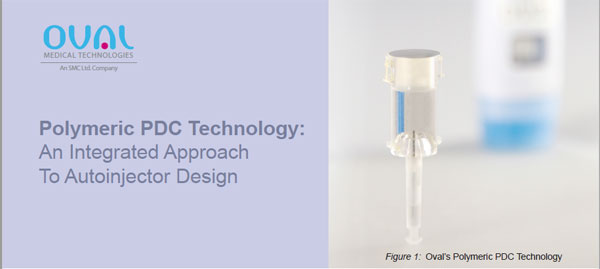|
Polymeric PDC Technology : An Integrated Approach To
Autoinjector Design

Over the past 20 years, there has been a shift in
pharmaceutical pipelines towards the development of
biologics, which make up ~70% of drugs currently in
development1. Biologics offer better efficacy and safety,
however the glass-based autoinjector technology used to
deliver these drugs has not significantly evolved since
the 1950s.
Subcutaneous injection is the preferred route of
administration for biologic drug delivery. With the need
to reduce costs, autoinjectors have become increasingly
important. Currently, single-use autoinjectors typically
comprise of a pre-filled glass syringe, an injection
mechanism for delivery of the drug, and a needle safety
mechanism for disposal of the device.
There are some advantages of using glass syringes as the
primary drug container (PDC) within an autoinjector
including;
Proven history of drug compatibility
Regulatory acceptance
Market familiarisation
Established manufacturing and filling processes
However, there are known issues with glass syringes, some
of which have led to autoinjector recalls;
Lubricants risk contamination
Tungsten contamination from glass
Plunger stiction leading to delivery inconsistency, that
can result in wet injections
Risk of glass breakage
Formulation viscosity and volume limitations
Large manufacturing tolerances
Complex supply chains reliant on specialist suppliers
The most recent innovations in biologics are now
presenting new challenges to the design of delivery
platforms. Innovations such as long-acting injectables (LAIs)
are being developed to provide slow-release capabilities.
The consequences, as with other biologics, are their
viscous formulations and complex fluid properties (e.g.
suspensions and emulsions with non-Newtonian properties).
The challenge is to balance complex drug characteristics
with delivered volume, whilst ensuring a patientcentric
approach. It is these requirements that are pushing the
limits of current glass-based technology.
Polymeric PDC technology offers a new approach that can
resolve many known glass issues, whilst unlocking
opportunities for the delivery of biologics. It is this
approach to autoinjector design that allows Oval Medical
to support a usercentric approach, unimpeded by the
performance, integration capabilities, and the limited
design freedoms of a glass-based alternative.
A USER-CENTRIC APPROACH
A user-centric approach to the medical device development
process is key in ensuring the design of devices which
promote correct, safe and effective use. The inclusion of
human factors engineering from the outset of the
development process allows for an understanding of user
group needs, their anticipated limitations and the
environment in which the device will be used. Ultimately,
the knowledge space that human factors engineering
generates allows minimisation of use-related risks, and
avoids inadequate device design which could compromise the
effectiveness of the device user interface.
The differences between user populations can be vast
patients with migraine may experience aurora, causing
visual impairment which hinders their ability to identify
device features or text. Alternatively, patients suffering
from anaphylaxis may require administration from a user
with good vision, but are naοve with respect to
autoinjector use. To create a well-considered and
intuitive device, these examples demonstrate that it is
essential to appreciate the various user group dynamics,
integrating them effectively into its design..
A truly user-centric approach must involve consideration
of the device interface design. The constraints presented
by glass PDC technology can limit the ability of a design
to meet all the functionality requirements which can
compromise the user interface. Frequently, the use of a
glass PDC leads to compromises in device size, form and/or
simplified use steps, preventing a device from fully
meeting the needs of its users.
Polymeric PDC technology (Figure 1) unlocks the
constraints of glass-based PDC systems through
facilitating an integrated approach to device design.
Whilst the autoinjector industry has been limited by its
reliance on glass-based technologies, polymeric PDCs allow
design freedoms traditionally unattainable in many areas
e.g. within user interface design. The result is that a
user interface can be fully tuned to the requirements of a
wide range of user populations without the burden of glass
breakage, dimensional variability and other known issues
associated with glass.
Use of polymers provides increased geometry options
combined with improved tolerance management not available
with glass. The benefits of polymer use include :
Delivery speed consistency (preventing wet injections
even when injecting challenging formulations e.g. non
Newtonian fluids)
Shorter injection times for viscous formulations,
without the risk of glass breakage
Needle depth consistency, reducing risk of adverse
events
Improved user experience through smaller gauge needles
|
